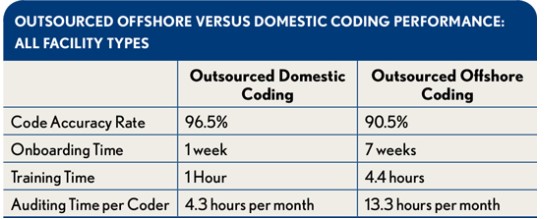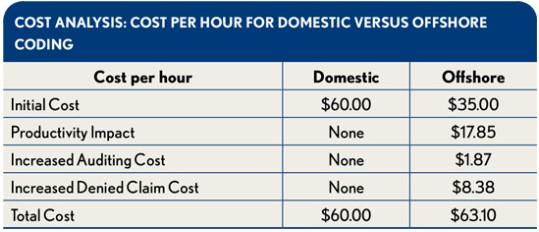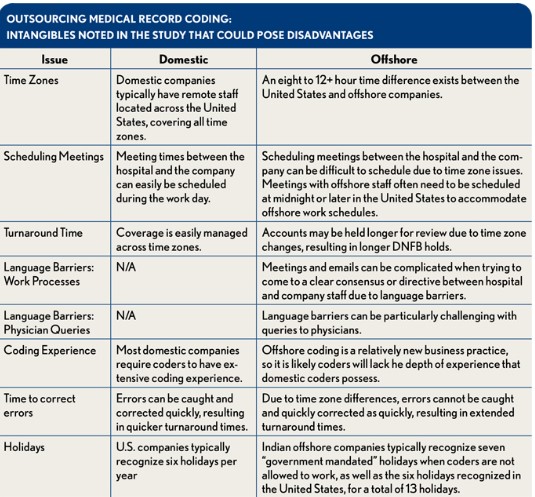Offshore Versus Domestic Outsourced Coding Services: A Comparative Assessment
Outsourcing medical record coding services overseas is often seen as an effective cost-control measure by U.S. healthcare organizations, but the recent experience of six organizations with this approach suggest this might not be the case.
In December 2017, Moody’s Investors Service reported that the overall decline in operating cash-flow for U.S. not-for-profit and public healthcare organizations was expected to decrease by 2 to 4 percent over the ensuing 12 to 18 months. This decrease is attributed partly to changes in payment and increases in labor costs. Collectively, U.S. hospitals have experienced median decreases of 2.7 percent in payment and 9.6 percent in cash-flow margins since 2015. a
This trend has prompted healthcare providers to constantly seek ways to minimize overhead and expenses, including reducing labor costs in medical record coding. In October 2016, Black Box Research reported, “Nearly 72 percent of hospital respondents are outsourcing more than half of their coding needs in 2016, up from 53 percent of hospitals before ICD-10 in 2015.” b Here, we address an important question facing healthcare revenue cycle executives: Are the advantages to offshore coding services better for our organization compared with domestic services?
Further Analysis Required
By outsourcing coding services, hospitals and health systems commonly discover cost savings in payroll, overhead, and benefits. Results of a 2017 survey by Black Book suggest that outsourced medical record coding is already considered best practice to improve coding accuracy, with the approach favored by 74 percent of respondents. c And the cost savings look even more significant if offshore resources are considered—at least from a high-level, cursory review. However, recent experience suggests that a deeper analysis is required.
Experience from a simultaneous engagement of offshore and domestic coders for their services from 2012 to 2015 provided some interesting comparative insights into some of the costs, benefits, and risks of domestic coding versus offshore coding. It also underscored the need for healthcare executives to consider other factors beyond the up-front cost to code, whether it is an hourly rate or a per encounter fee, when considering the option of offshore medical record coding services versus domestic services.
Is Offshore Really Cheaper?
Many companies offer outsource medical record coding services—an internet search results in several pages of possibilities. Many of the companies are in the United States and provide the option to select domestic or offshore coders; others are offshore-only companies. Typically, the offshore option is less expensive—at first glance.
Partners Healthcare (PHC), the largest private employer in Massachusetts, announced Feb. 20, 2018 that 100 employees—the majority of them coders who earn upwards of $40 per hour—were being let go and their jobs outsourced to India. Massachusetts state law requires healthcare providers to keep spending growth to 3.1 percent a year, so PHC leaders are hoping this move will allow them to maintain these margins, because the outsourcing expense is expected to be a fraction of the current amount. d
PHC’s decision to outsource the coding function to India may seem to make sense when one compares the lower hourly wage. However, there is more to the coding process that is not readily apparent from a spreadsheet.
2 Years, 6 Findings
During the previously cited engagement with domestic and offshore coding companies—lasting from January 2015 through January 2017 and involving five offshore coding companies—six significant patterns in offshore medical record coding services performance were noted. These patterns suggested that use of offshore coding can result in:
- Lower productivity, requiring more FTEs to manage the patient volume
- Lower accuracy, requiring additional feedback from management on errors and more time spent auditing to minimize errors, resulting in more training time
- Higher denial rates, requiring more time to rework denials
- Fewer queries on inpatient encounters, leading to a lower payment levels and a 0.1 decrease in case mix index (CMI), equating to a $4,500 reduction in payment, on average, per inpatient encounter
- Excessive onboarding time for new coders, causing issues in management staffing levels to changes in patient volume
- Slower turnaround time, leading to an increase in discharged-not-final-billed (DNFB) cases
When all these issues were taken into account, the overall cost savings of offshore coding was less than expected. Digging deeper into the data from six the healthcare organizations that received domestic and offshore coding services under this engagement yielded more detailed coding fluctuations between domestic and offshore coding services.
Comparative Performance at Six Health Systems
The six organizations closely tracked metrics for coding productivity, accuracy, training, and denials for both domestic and offshore medical record coding services over the two years. All organizations used both types of outsourced coding services during the measurement period. The facilities included:
- A teaching hospital with annual revenue of $2.7 billion
- A $3.8 billion not-for-profit healthcare organization consisting of nine hospitals and rehabilitation centers
- A university-based teaching facility with annual revenues of $5.4 billion
- A not-for-profit system that included four acute-care facilities with annual revenue of $1.8 billion
- A small full-service hospital with annual revenue of $188 million
- A not-for-profit tertiary care center with annual revenue of $2 billion
The same onboarding, auditing, and training procedures were applied equally to all. Coding accuracy rates, training times, and onboarding times were tracked for domestic and offshore coding services.
To analyze performance by type of facility, the two health systems were included within one category, the two teaching facilities and large tertiary care center were placed into a category, and the small community hospital was listed separately. Three averages were then calculated to identify any differences in offshore coding outcomes by facility type: inpatient accuracy, onboarding, and training time.

The only dramatic difference in offshore coding performance for these three metrics was with onboarding time—the multi-hospital health systems took longer to onboard their offshore coding partners. Despite lack of variances by facility, the data provide a solid benchmark for organizations considering offshore coding services.
Greater differences were noted when comparing outsourced offshore versus outsourced domestic coding accuracy, onboarding, training, and auditing requirements, regardless of facility type. Herein lies important time and cost considerations for healthcare revenue cycle executives. Poor coding quality increases payer denials, while additional management time required to onboard, train, and audit outsourced coders increases operational costs. These factors, therefore, are important considerations for any organization that is contemplating whether to outsource coding to an offshore service provider versus a domestic one.

The final step in our analysis was to make a fully loaded cost comparison of these six facilities’ experiences with outsourced offshore and domestic coding services.
Bottom-Line Cost Summary
Cost of coding was determined by comparing services on an hourly basis. The six organizations in this study were charged varying rates per hour or by chart, across five different patient types, from four different offshore vendors. For purposes of this study, $60 per hour for domestic coding and $35 per hour for offshore coding was used.

Management fees were calculated at $50 per hour, the domestic outsourced coding company’s actual average salary, plus benefits provided to managers, assistant managers, and auditors. Management fees for domestic coding are included in the $60 cost of coding. Management fees for offshore coding are an additional expense required by the client, as described below.
Three other factors were considered: productivity, auditing requirements, and denied claims.
Productivity. Because offshore coder productivity was 34 percent lower per hour than domestic coders, the study assumes organizations need 51 percent more offshore coders at $35 per hour to accomplish the same volume of work by domestic coders at $60 per hour. This raises the effective hourly rate of offshore to $52.85 per hour—an increase of $17.85 per hour.
Auditing. Offshore coders required an average of 6 more hours per coder per month of auditing due to poor accuracy results. Six hours per month at $50 per hour equal an additional expense of $300 per month per coder. When spread across a single coder’s 160 hours per month of coding, this amount adds $1.87 per hour to the cost of offshore coding.
Denied claims. Offshore coders averaged 10 more denied claims on inpatient-and-same-day-surgery (SDS) encounters per week than domestic coders. Denied claims are reworked by the management staff, and the coder is retrained on the errors. Reworking of denied claims on these patient types takes 20 minutes each to recode and 20 minutes each to retrain the coder on the errors for a total of 40 minutes each. For 10 additional claims per week, the additional management time is 400 minutes, or 6.7 hours per week, times $50 per hour, which equals $335 for week. This raises the cost of a 40-hour-per-week coder by $8.38 per hour.
These study findings suggest offshore coding is a more expensive option than domestic coding due to additional costs of rework, auditing, and lower productivity. Beyond these bottom line calculations, there are also intangible challenges involved when different languages and cultures enter the coding mix as listed below.
Blending Languages and Cultures for Outsourced Offshore Coding
Managing coders amidst varying time zones and languages is very difficult. When working with offshore partners, coding managers are required to conduct meetings at odd hours. For example, in the study described here, training sessions for international partners needed to be conducted at midnight, right as the offshore coders’ shifts were starting. This finding suggests that healthcare organizations considering an offshore coding service should specify training, conference calls, and other communication time preferences as part of the contracting process.

The study also found that email communication often was complicated in attempts to achieve a clear consensus across offshore and domestic teams. Language differences were most notable when physicians were queried for additional specification as required to properly code cases in ICD-10. This experience suggests physician queries are the most important cultural issue to watch with outsourced offshore coding services.
From an education and training perspective, it was clear the offshore coders generally lacked the years of experience the domestic coders possessed. Moreover, due to time zone differences, managers were not able to catch errors and make corrections as quickly as they could with domestic coders. Finally, accounts also tended to be held longer in discharged-not-final-billed (DNFB) status pending additional coder review or awaiting management responses. Other cultural considerations includes transportation, family events, and government holidays.
Transportation. The offshore coders in the study relied on public transport (sometimes involving multiple transport changes enroute), creating a barrier to staff arriving early or staying late to accommodate meetings with U.S. counterparts.
Family events. Celebration events tended to be extended. For example, a marriage in India resulted in the coder being out of the office for three or four weeks. Traveling back “home” to visit family can be a month-long vacation.
Government holidays. Other countries mandate holidays where coders are not permitted to work, and the international team in the study also recognized the U.S holidays.
These cultural, time zone and language barriers should be addressed during contract negotiations and accommodations made with the offshore provider. Contractual issues surrounding productivity, accuracy, privacy, security, and training could also be carefully stipulated as points for the offshore vendor to address.
Build Your Checklist
Outsourced coding services to any vendor, domestic or offshore, carries important responsibilities for revenue cycle executives and health information management leadership. From securing the contract to managing day-to-day operations, there are many service-agreement nuances to consider including those mentioned above. The following questions are additional components to include during coding partnership conversations and within outsourced coding contracts.
- Can the prospective coding partner guarantee that discharges will be coded within 48 hours of chart completion?
- Is the prospective partner prepared to provide reimbursement for the provider organization’s excess management time spent on reworking denials, training, onboarding, and auditing?
- What notification, communication, remediation, and escalation policies does the company have in place for client problems, issues and concerns?
- Does the company have a formal sanctions policy for privacy violations?
- Do all the company’s workforce members receive privacy training upon hire and periodic privacy retraining thereafter?
- Does the company have a business associate agreement in place with all workforce members who access patients’ protected health information (PHI)?
- Does the company maintain a current inventory of all systems and devices that contain and access PHI?
- Does the prospective partner physically inspect or have photo evidence of each staff member’s workplace?
In addition to asking these question, the healthcare organization should request copies of the ourtsource coding company’s policies and procedures governing the use of virus protection software and patch management software (which should include provisions ensuring all software is up to date and fully supported), as well as its policies on password management and safeguards.
By mitigating concerns raised by the six hospitals in this article’s study, healthcare organizations ensure a smooth working relationship and informed comparative assessment between domestic and offshore coding services.
Footnotes
a. Moody’s Investors Service, “Moody’s: US not-for-profit and public healthcare outlook changed to negative with rising operating pressure,” Announcement, Dec. 4, 2017.
b. Black Box Research, “Outsourced HIM and Computer-Assisted Coding Seen as Panacea for Regaining Lost Productivities and Post ICD-10 Payments, Says Black Book Hospital Survey,” Press release, Cision PR Newswire, Oct. 4, 2016.
c. Black Box Research, “Outsourced Coding and Health Information Management Market Expected to Double Again in 2018, Black Book Survey Reveals Top Vendors,” Press release, Cision PR Newswire, Oct. 4, 201.
d. Kowalczyk, L. and McCluskey, P.D.,“Partners Healthcare Will Outsource Some Expensive, Back-Office Jobs to India,” Boston Globe, Feb. 20, 2018.





